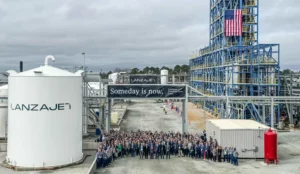
Credit: LanzaJet
LanzaJet Throws Open the Doors
Chicago area company LanzaJet opened its first commercial scale facility in Georgia. I’ve written about this company previously because they represent the potential of a new pathway to make sustainable aviation fuel. Currently, it’s made from cooking grease, which works, but we don’t eat nearly enough french fries for there to be enough waste grease to address the jet fuel market in a big way. In comparison, we have an enormous amount of ethanol refining capacity (40% of the corn grown in the US goes to make ethanol), and there are emerging technologies that can enable the production of ethanol from ag waste, not just ag crops. The company also announced a major investment from Southwest Airlines in order to build a facility which Southwest will buy the fuel from. Besides being a cool local company, it is additionally exciting that it is the airlines themselves who are generating interest here (not federal regulation).

The BYD Dolphin hatchback. Credit: BYD
BYD – Do You Know Me?
Chinese automaker BYD is making moves. The company recently unveiled a hatchback electric vehicle model for less than $14,000 in China (for comparison, an entry level Toyota Camry or Chevy Equinox is around $26,000). Even more notable than the low price is that this model was about 15% cheaper than the previous model, demonstrating the continued cost declines the company is achieving as it scales.
BYD is scaring a lot of people because they are making good electric vehicles and hybrids very cheaply. It is my walking around impression that during the pandemic, no one from the west really went to China, and when travel restrictions lifted, many industry stakeholders were shocked at how good new chinese vehicles were. They are gobbling market share in middle income countries, and starting to sell in Europe as well.
The United States has robust tariffs against Chinese cars currently, although BYD is exploring setting up manufacturing in Mexico, which would enable them to bypass these duties. Even if you assume significant cost markups to move to North America (high labor costs, more stringent safety standards, maybe you make the car bigger), it seems plausible than in a few years BYD could show up to sell a vehicle that is the most affordable car on the market by a large margin – something that Detroit automakers will be taking extremely seriously.
And BYD is not the only Chinese company making impressive strides on electric vehicle costs – the major battery manufacturer CATL (which works with numerous major automakers in the US) announced it was on track to cut the price of its LFP batteries by half over 12 months. This is a PR announcement, but a reflection of how dramatically the market is changing (LFP chemistry batteries provide less driving range than nickel-rich chemistries, but they are cheaper and use fewer rare minerals, so are increasingly the choice for automakers in China and beyond).
If you’re interested in this topic, check out this recently published opinion piece from Robinson Meyer in The New York Times.
Venture Distributions (or Lack Thereof)
Pitchbook highlighted that across the venture ecosystem, cash distribution (that is, investors getting money back from the funds they invested in) sank to a 14-year low. This is an important factor that I emphasize when talking to founders about fundraising. Although it is a challenging market for startups to be fundraising in, the venture funds they are trying to fundraise from are under related pressures – with many unable to raise their own new funds and without a whole lot of good news to share with their investor base.

Ovoids, or “Fairy Circles,” that may signal deposits of geologic hydrogen. Credit: Engie
I’m Digging This Geologic Hydrogen Stuff
The hottest flavor of hydrogen that you may never have heard of is Geologic Hydrogen (or “white” hydrogen for you color wheel folks – my colleague is color blind so I don’t want to assume). Koloma recently raised a quarter of a billion dollars to try to identify and extract hydrogen from under the earth’s surface. This is an exciting space to watch – there’s a whole bunch of hydrogen in natural deposits, and if companies are able to leverage the expertise and advances in drilling from the fossil fuel industry, it could be a gigantic opportunity. ARPA-E feels similarly – it just announced $23 million in funding for 18 projects related to geologic hydrogen. There are definitely challenges of course – a major cost component of hydrogen is transportation, so the deposits would need to be in a useful place logistically.
Other News
Vineyard Wind is up and running – the first large scale offshore wind farm in the United States.
Northwestern spinout Lilac Solutions raised $145 million to deploy it pioneering direct lithium extraction technology at the Great Salt Lake in Utah.
There continues to be a lot of debate around recently announced guidance for the green hydrogen tax credit (45v), specifically the hourly matching requirements. Proponents see this as necessary to drive actual emissions reductions; opponents think these rules are overly onerous and will stifle new green hydrogen development.
Several Midwest states are preempting local roadblocks to renewable energy deployment.
Hyundai is building a new domestic EV manufacturing plant in Georgia to qualify for the $7,500 subsidies passed in the Inflation Reduction Act,
New FERC Commissioners were nominated. FERC is the most important energy transition entity you barely know exists, but heavily influences the development trajectory of renewable energy (and other sources for that matter) given their role overseeing interconnection, transmission planning, and power markets.